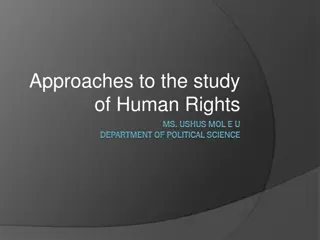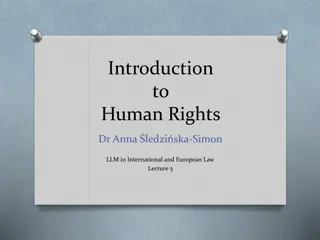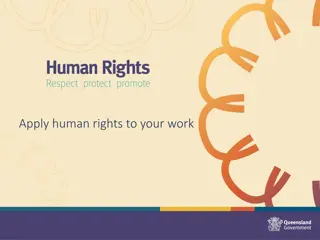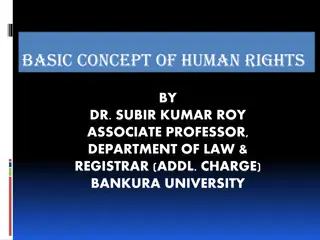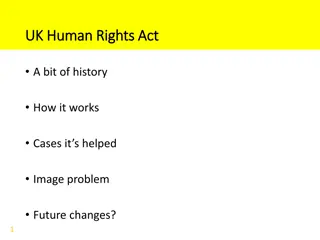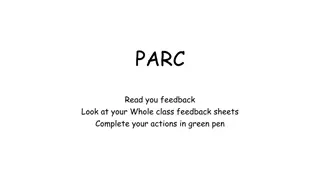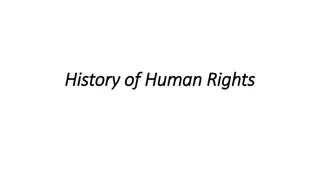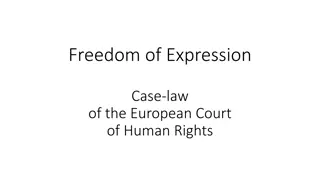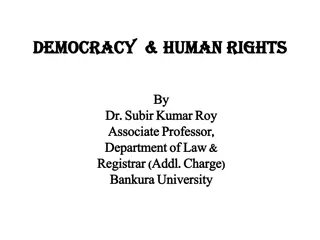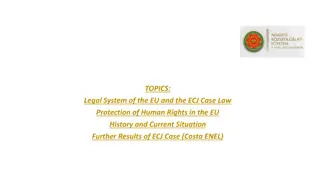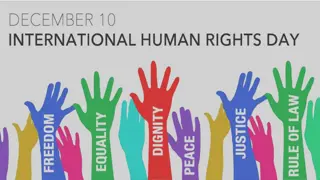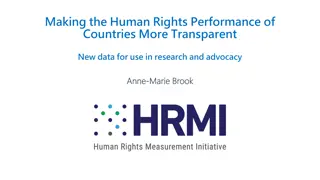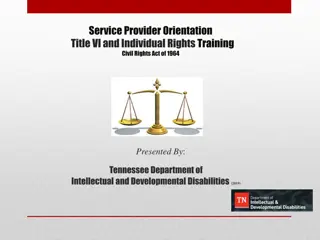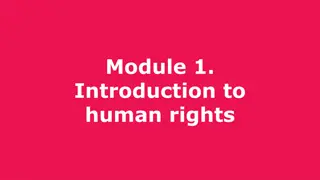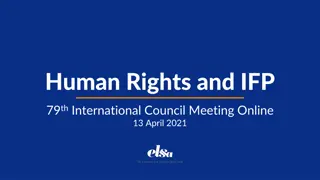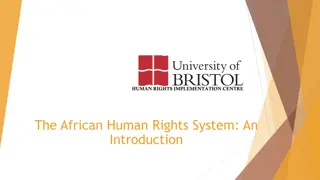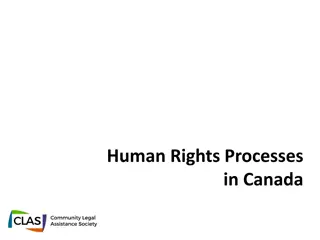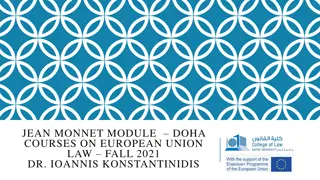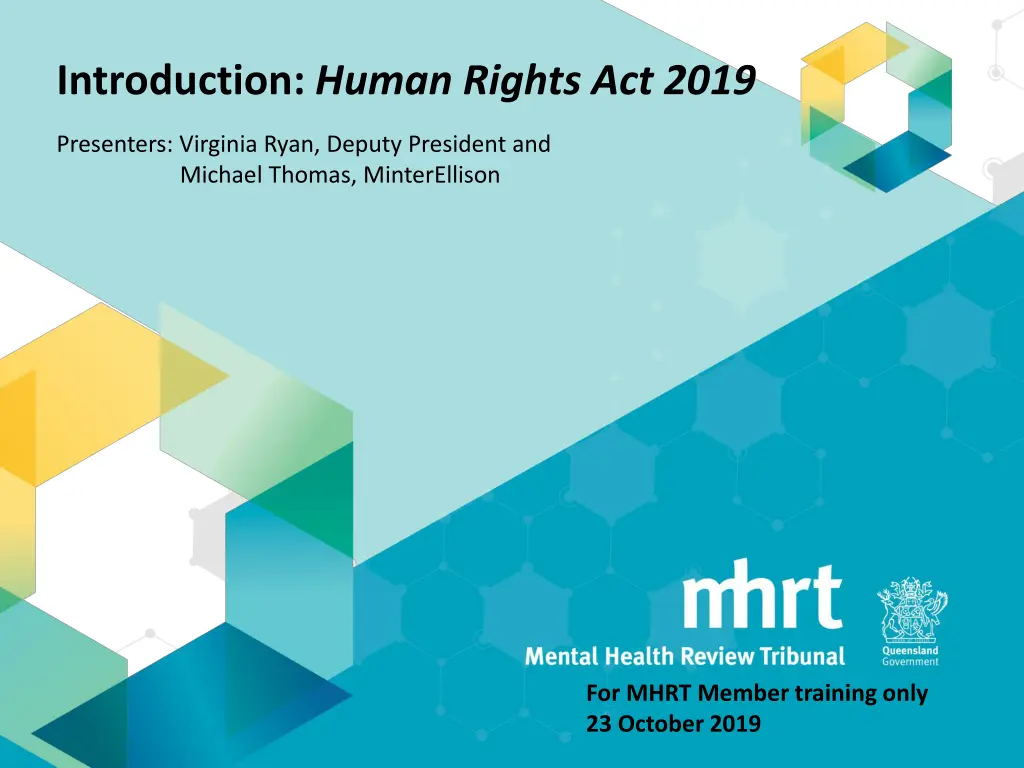
Understanding the Human Rights Act 2019 and Its Impact on MHRT Members
Explore the Human Rights Act 2019, its objectives, and the implications for Mental Health Review Tribunal members. Learn about how the act protects and promotes human rights, the limitations, and the policy changes for MHRT operations.
Download Presentation

Please find below an Image/Link to download the presentation.
The content on the website is provided AS IS for your information and personal use only. It may not be sold, licensed, or shared on other websites without obtaining consent from the author. If you encounter any issues during the download, it is possible that the publisher has removed the file from their server.
You are allowed to download the files provided on this website for personal or commercial use, subject to the condition that they are used lawfully. All files are the property of their respective owners.
The content on the website is provided AS IS for your information and personal use only. It may not be sold, licensed, or shared on other websites without obtaining consent from the author.
E N D
Presentation Transcript
Introduction: Human Rights Act 2019 Presenters: Virginia Ryan, Deputy President and Michael Thomas, MinterEllison For MHRT Member training only 23 October 2019
Overview 1. What is the Human Rights Act 2019? 2. How does it apply to the Mental Health Review Tribunal and its Members? 3. What are the Human Rights? 4. How can the rights be limited? 5. What are the consequences? 1. Human rights complaints 2. Legal Proceedings 3. Referral to the Supreme Court 6. Changes to templates
Where else to find information We will make resources available on the members-only section of the MHRT website. We will add a copy of the Human Rights Act 2019. Currently:
What is the Human Rights Act 2019? The Human Rights Act 2019 was passed by the Queensland government on 27 February 2019 and will commence operation on 1 January 2020. The main objectives of the Human Rights Act 2019 are: a) To protect and promote human rights; b) To help build a culture in the Queensland public sector that respects and promotes human rights; and c) To help promote a dialogue about the nature, meaning and scope of human rights. Have a read of the Act it is quite short. Very similar to Victoria s Charter of Human Rights and Responsibilities.
Impact on Mental Health Review Tribunal and Members?
Impact on MHRT and Members As a part of the Queensland public sector, the MHRT needs to promote a human rights culture. This will extend to MHRT functions both as a public entity and as a tribunal. The MHRT will introduce a policy effective 1 January to address human rights. Key principles: The MHRT is committed to creating and maintaining a work environment which promotes, protects and has a culture that is respectful of human rights. The policy should be read as informing and underpinning all other policies and procedures that may touch upon or limit the human rights protected by the Human Rights Act 2019. For the purposes of the Human Rights Act 2019, Members are public entities and must conduct themselves at all times in a manner which is compliant with the Human Rights Act 2019. This requires Members to act and make decisions in a manner that is consistent with human rights. Additionally, when sitting as a panel, Members constitute the Tribunal. It is expected that at all times while constituting the Tribunal, Members will when interpreting statutory provisions, only do so in a way that is compatible with human rights, to the extent possible that is consistent with the purpose of the provision being interpreted.
As a Tribunal Required to act and make decisions in a way compatible with human rights. May refer the following to the Supreme Court: Question of law arising in relation to the application of the Human Rights Act 2019. Question relating to the interpretation of a statutory provision in accordance with the Human Rights Act 2019. We will discuss referrals to the Supreme Court shortly.
As a Tribunal Section 48: (1) All statutory provisions must, to the extent possible that is consistent with their purpose, be interpreted in a way that is compatible with human rights. (2) If a statutory provision can not be interpreted in a way that is compatible with human rights, the provision must, to the extent possible that is consistent with its purpose, be interpreted in a way that is most compatible with human rights. (3) International law and the judgments of domestic, foreign and international courts and tribunals relevant to a human right may be considered in interpreting a statutory provision. (4) This section does not affect the validity of: (a) an Act or provision of an Act that is not compatible with human rights; or (b) a statutory instrument or provision of a statutory instrument that is not compatible with human rights and is empowered to be so by the Act under which it is made. (5) This section does not apply to a statutory provision the subject of an override declaration that is in force.
As a public entity Required to act and make decisions in a way compatible with human rights. Exposed to potential legal proceedings for acts or decisions not compatible with human rights. Exposed to potential complaints to the Queensland Human Rights Commissioner.
As a public entity (4) This section does not apply to an act or decision of a private nature. For subsection (1)(b), giving proper consideration to a human right in making a decision includes, but is not limited to: (a) identifying the human rights that may be affected by the decision; and (b) considering whether the decision would be compatible with human rights. (6) To remove doubt, it is declared that: (a) an act or decision of a public entity is not invalid merely because, by doing the act or making the decision, the entity contravenes subsection (1); and (b) a person does not commit an offence against this Act or another Act merely because the person acts or makes a decision in contravention of subsection (1). Section 58: (1) It is unlawful for a public entity: a) to act or make a decision in a way that is not compatible with human rights; or b) in making a decision, to fail to give proper consideration to a human right relevant to the decision. Subsection (1) does not apply to a public entity if the entity could not reasonably have acted differently or made a different decision because of a statutory provision, a law of the Commonwealth or another State or otherwise under law. Also, subsection (1) does not apply to a body established for a religious purpose if the act or decision is done or made in accordance with the doctrine of the religion concerned and is necessary to avoid offending the religious sensitivities of the people of the religion. (5) (2) (3)
What are the Human Rights? The Human Rights Act contains 23 distinct human rights. You should be familiar with these 23 rights. They are found in sections 15 37 of the Human Rights Act. We will include information on the rights on the members resources section of the MHRT website. Of these rights, we have identified: 8 that are likely to arise frequently during the normal operation of the MHRT s functions. 10 that are of general relevance to the normal operation of the MHRT s functions. 5 that are not likely to be applicable to the normal operation of the MHRT s functions. These are our suggestions only based on what we have seen in Victoria.
What are the Human Rights? Recognition and equality before the law (s15) Freedom of expression (s21) Peaceful assembly and freedom of association (s22) Right to life (s16) Protection from torture and cruel, inhuman or degrading treatment (s17) Taking part in public life (s23) Property rights (s24) Privacy and reputation (s25) Freedom from forced work (s18) Protection of families and children (s26) Freedom of movement (s19) Cultural rights generally (s27) Freedom of thought, conscience, religion and belief (s20)
What are the Human Rights? Cultural rights Aboriginal peoples and Torres Straight Islander peoples (s28) Children in the criminal process (s33) Right not to be tried or punished more than once (s34) Right to liberty and security of person (s29) Humane treatment when deprived of liberty (s30) Retrospective criminal laws (s35) Fair hearing (s31) Right to education (s36) Rights in criminal proceedings (s32) Right to health services (s37)
The Human Rights We won t go into too much detail about the relevant human rights now. This is the subject of a second Masterclass 13 November 2019. You will see that many of the human rights are considerations that you are having regard to already in your decision-making.
Mental Health Act Section 3(2)(a) and (b): The main objects of the Act are to be achieved in a way that safeguards the rights of persons and is the least restrictive of the rights and liberties of a person who has a mental illness. The principles in section 5 must be applied when administering the Act. For example: the right of all persons to the same basic human rights must be recognised and taken into account The person s right to respect for his or her human worth and dignity as an individual must be recognised and taken into account. To the greatest extent practicable, a person is to be encouraged to take part in making decisions affecting the person s life, especially decisions about treatment and care. To the greatest extent practicable, in making a decision about a person, the person s views, wishes and preferences are to be taken into account. A person s age-related, gender-related, religious, communication and other special needs must be recognised and taken into account. There are other principles specific to Aboriginal people and Torres Strait Islanders, persons from culturally and linguistically diverse backgrounds and minors. Section 733(3)(a): In conducting a proceeding, the tribunal must observe the rules of natural justice.
Limitation of rights Just because a human rights is included in the Human Rights Act does not mean it is unlimited. An act, decision or statutory provision is compatible with human rights if it: does not limit a human right; or limits a human right only to the extent that is reasonable and demonstrably justifiable in accordance with section 13.
Section 13 test A human right may be subject under law only to reasonable limits that can be demonstrably justified in a free and democratic society based on human dignity, equality and freedom. In deciding whether a limit on a human right is reasonable and justifiable, the following factors may be relevant: a) the nature of the human right; b) the nature of the purpose of the limitation, including whether it is consistent with a free and democratic society based on human dignity, equality and freedom; c) the relationship between the limitation and its purpose, including whether the limitation helps to achieve the purpose; d) whether there are any less restrictive and reasonably available ways to achieve the purpose; e) the importance of the purpose of the limitation; f) the importance of preserving the human right, taking into account the nature and extent of the limitation on the human right; g) the balance between the matters mentioned in paragraphs (e) and (f).
A process to follow 1. Identify relevant rights: what rights are relevant to the situation. 2. Consider the impact: will your decision limit or restrict any of the relevant rights you ve identified? No: if rights are not being limited, you are acting compatibly with human rights. Yes: if human rights are being limited, move to step 3. 3.Determine whether the limit is reasonable and justified. Consider the following questions
A process to follow Is it lawful? What law or regulation allows you to limit a person s rights? Is there a purpose? What is the aim of the limitation? Does it achieve a legitimate purpose? Is it reasonable? Will what you are doing effectively achieve your purpose? Is it necessary? Is this the least restrictive way to achieve your purpose? Is it fair and balanced? Do the benefits outweigh the harm caused by the limitation?
What are the consequences? 1. Complaint to the Queensland Human Rights Commission 2. Legal proceedings 3. Referral to the Supreme Court This Photo by Unknown Author is licensed under CC BY-NC-ND
Complaints Complaints under the Human Rights Act are not able to be lodged until after 1 January 2020. Complaints under the Human Rights Act will only be able to be made about alleged breaches which occur after 1 January 2020. Complaints must be first made to the relevant public entity. Entity has 45 days to provide an adequate response. Complaint can then be made to the Queensland Human Rights Commission. QHRC may refuse to deal with a complaint including if they consider there is a more appropriate course of action under another law. Available mechanism of resolution is conciliation. QHRC may publish information about a human rights complaint that they have finished dealing with.
Legal Proceedings Can only join a ground of breach of the Human Rights Act to existing legal proceedings. Cannot be an action of itself. Person is not entitled to be awarded damages.
Referral to the Supreme Court Where a question of law arises in relation to the application of the Human Rights Act or the interpretation of a statutory provision in accordance with the Human Rights Act. Referrals may be made when: a party to the proceeding applies for a referral; and the Tribunal considers it appropriate to refer the question. If a question is referred to the Supreme Court, the Tribunal must not: make a decision about the matter to which is the question is relevant while the referral is pending; or proceed in a way that is inconsistent with the Supreme Court s decision on the question. What do I do if I get a referral application? Consider the application on its merits. Is it vexatious or without merit? Is it appropriate to be decided by the Supreme Court? Can you make the decision in a way that you consider is compatible with human rights or is appropriately limiting taking into account section 13? MHRT will provide further guidance on this once more is known from the Department of Justice and Attorney-General.
Changes to templates The Tribunal will update templates to prompt for inclusion of information about human rights including
SOR templates For example: Human Rights [Provide a summary of the human rights considerations made by the Tribunal in reaching the decision. Some examples are given for you below. Your summary should include: reference to whether a party made submissions/raised issues that identified the limitation of a human right in any case, which human rights, if any, were identified by the Tribunal as being engaged and/or limited the reasons that the Tribunal has for considering that those limitations are demonstrably justified.] Below are two examples of paragraphs you may like to use. The Tribunal acknowledges the Human Rights Act 2019. In particular, the Tribunal considers that the following human rights under that Act are potentially engaged and limited by the decision of the Tribunal: [list human rights identified]. However, the Tribunal is satisfied that the restrictions placed on [the patient] by the Tribunal are lawful, proportionate to the circumstances and compatible with the Human Rights Act. The Tribunal reached this decision because [outline why the limits on human rights are appropriate]. OR The Tribunal considered the relevant human rights set out in the Human Rights Act 2019. [List the human rights that you considered] are potentially engaged and limited by the Tribunal s decision. Taking into account the following, the Tribunal is satisfied that the limits imposed by the Tribunal s decision are reasonable and justified in accordance with section 13 of the Human Rights Act: [list the reasons that the Tribunal considers the limits on the identified human rights are justified]. [Reasons for the justification for limitation of human rights may include: the criteria of the relevant test under the Mental Health Act were met and thus the confirmation of the authority is lawful and within the jurisdiction of the Mental Health Act the authority has been determined to be the least restrictive way for the person to receive treatment and care the human rights engaged have been balanced against the risk to the person s health and wellbeing that is likely to eventuate if the person does not receive treatment and care under the authority.]
Records of Proceedings ROP updated to include: A new heading. For example: Human Rights Considerations (i) rights potentially engaged/limited and (ii) consideration of reasonable limitations. A new adjournment reason: Referral to the Supreme Court pursuant to section 49 of the Human Rights Act , together with space to write the question to be referred to the Supreme Court. Member Notes updated to include a prompt to record human rights considerations in deliberations. For example: Ensure your deliberation notes include consideration of the human rights that are potentially engaged and limited by your decision and the reasons why any limitation is justified.
Clinical Reports Prompt to include information in the cultural section. For example: [Comment on any ways in which the treatment authority and/or treating team s recommendations may engage or limit the person s cultural rights see sections 27 and 28 of the Human Rights Act 2019] In the summary of recommendation section. For example: Human Rights Provide details of any human rights that are engaged and/or limited by the recommendations (see sections 15 37 of the Human Rights Act 2019. If any rights are limited, describe why the recommendations are demonstrably justified in this person s circumstances.
ECT Application A new section, for example: Human Rights: Provide details of the considerations given to the patient s human rights pursuant to the Human Rights Act 2019.
Decision Notices Where decision notices contain suggestions/options for wording of conditions, for example: Consider conditions such as these if the category is COMMUNITY or if the category is INPATIENT and option 3 is selected. Remember to consider if each condition is required individually.
Hearing Notices We are also revisiting hearing notices with the aim of improving the language and layout to make them easier to understand.
Important to remember In your capacity as a Member of the MHRT, you are a public entity for the purposes of the Human Rights Act individually. Just because a human rights issue arises while you are acting as a Member of the MHRT does not mean that a complaint or legal proceedings will only be brought against the Tribunal. Complaints and legal proceedings can be brought against you personally.
How to view human rights [consideration of human rights] is supposed to be a common or garden activity for persons working in the public sector While I accept that the requirement to give proper consideration to a relevant human right requires a decision maker to do more than merely invoke the Charter like a mantra, it will be sufficient in most circumstances that there is some evidence that shows the decision-maker seriously turned his or her mind to the possible impact of the decision on person s human rights and the implications thereof for the affected person, and that the countervailing interests or obligations were identified. Castles v Secretary to the Department of Justice & Ors [2010] VSC 301 at [185] & [186] per Emerton J
Tips & Tricks The best defence is good documentation. Document your reasoning including which human rights are being engaged and limited and which human rights are being protected. Learn the human rights. Keep the human rights in mind when making decisions (it is supposed to be a common or garden activity ). Human rights work both ways, although your decision may limit human rights, it is likely your decision will also be to protect human rights. Follow and complete the prompts on updated MHRT forms and guidance.

